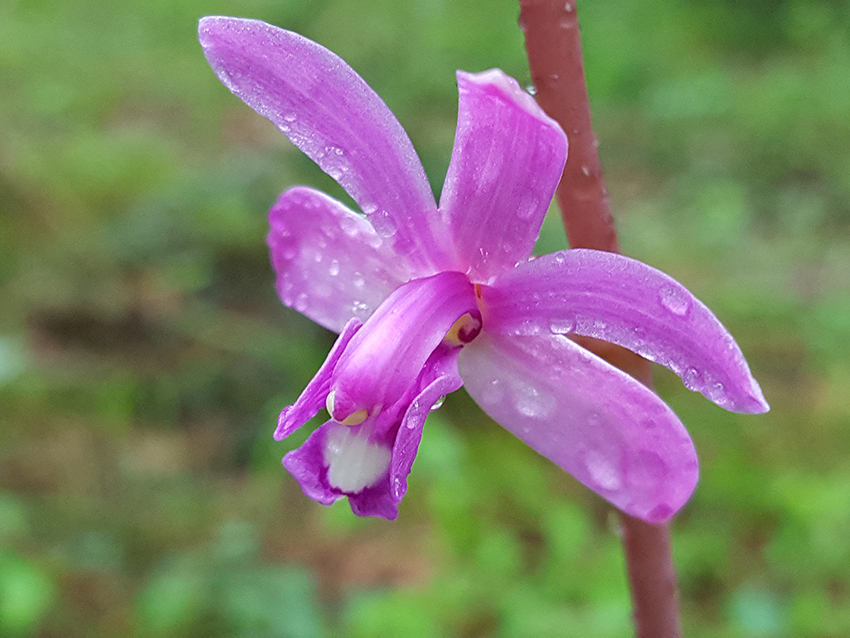A strangely vivid purple flower was recently found in the forested area at Brackenridge Field Lab, located on Lake Austin Boulevard.
The purple species, Hexalectris grandiflora, is a native orchid species of Texas that has not been spotted in over 50 years. The species was thought to be restricted to Mexico and the
Trans-Pecos region of West Texas.
Dr. Rob Plowes, an ecology research scientist at Brackenridge, said this important find was followed by the discovery of a second rare orchid called Hexalectris arizonica about 50 yards away from the first orchid. Plowes has been studying these orchids, which are both coral root orchids, since their discovery.
Both of these plants appear to live most of their lives underground and only sprout above ground when it is time for their seeds to be pollinated. Plowes said that H. grandiflora seems to be pollinated by a particular type of bee but that H. arizonica appears not to have any specific pollinator.
“That is another mystery that we’re trying to solve,” Plowes said. “We don’t know what species of bee even pollinates [H. grandiflora].”
Five different species of coral root orchid species have been found in the lab field area since 1996. According to Dr. Lawrence Gilbert, an integrative biology professor and Director of the Brackenridge field stations, these rare coral orchids are different than any other known orchid species.
“Coral root orchids represent a lifestyle that has evolved independently over 20 times across more than 25,000 species worldwide,” Gilbert said. “They not only lack leaves, but have lost any ability to carry out photosynthesis. Instead, they depend entirely on fungal symbionts for nutrients.”
These “mycoheterotrophic” orchids have a symbiotic relationship with an ectomycorrhizal fungi found in the soil. The fungi connect the orchids to roots of trees. Gilbert said that studies indicate that these orchids obtain nutrients from the trees through this fungi.
Each of the six H. grandiflora plants in the field had six to eight flowers that open over a period of six weeks. Plowes said his current hypothesis is that the plant flowers over a certain period of time to train pollinators to know when to pollinate. H. grandiflora uses a pollinator to carry its pollen to other flowers and distribute them for reproduction.
The second orchid, H. arizonica, is a creamy red flower and is even more rare than H. grandiflora. Only two H. arizonica plants with six flowers each were found. Plowes said that an interesting fact about H. arizonica is that its flowers don’t fully open, limiting pollinators’ access to the pollen inside. Instead, the plant self-pollinates and feeds off of ectomycorrhizal fungi in the soil.
“If you think about it, it’s not surprising that a flower as rare as this would adapt to self-pollination as we have not found a species that pollinates it,” Plowes said.
Plowes said that these species may be growing in the Austin area for the first time because of surplus rainfall over the past two years.
“The El Niño event may have provided sufficient moisture and resources that caused the plant to flower,” Plowes said. “It’s not uncommon in nature for other plants and insects to have these long periods of 15 to 20 years between their reproductive events.”
Because these orchid species survive severe droughts by adapting to seek out moist conditions under rocks, it makes sense that they were found at the Brackenridge Field Lab, which was previously a limestone quarry. Gilbert said that coral root orchids appear to associate with plants and trees found in limestone areas. However, the native environment of these rare orchids is
currently unknown.
Plowes intends to use these specific plants to learn more information about how and where these species grow, pollinate and disperse, and how they manage to survive in a way not documented in other orchid populations.
“That way we will understand a little more about why they are where they are, how they manage to live, and why they flower so erratically over long periods,” Plowes said. “We don’t understand the basis of what they do.”















